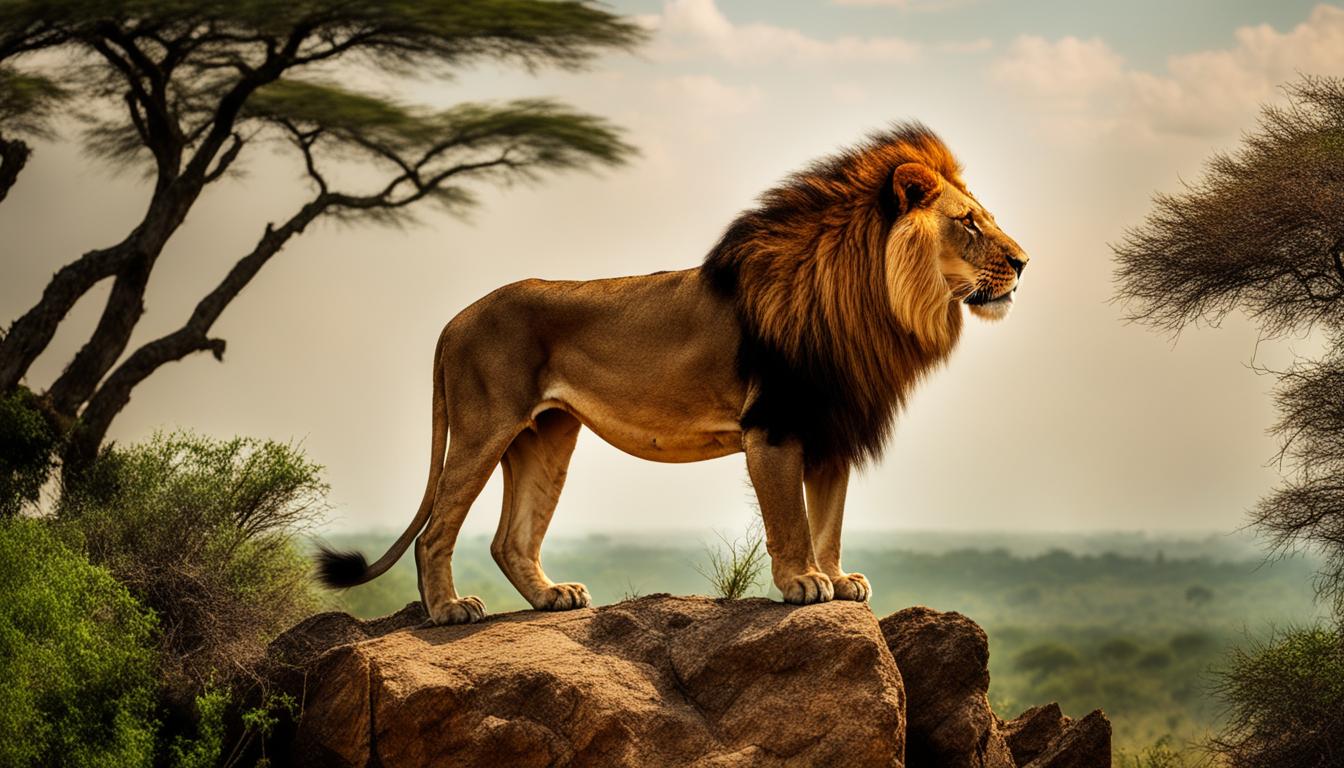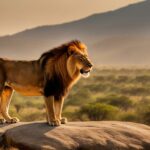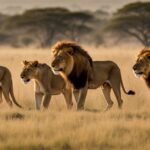Lions are majestic creatures that have a profound impact on the ecosystems they call home. As top predators, they play a crucial role in maintaining the delicate balance of nature. Their presence influences not only the populations of herbivores but also the overall biodiversity and ecological health of their habitats. Let’s explore the various ways in which lions shape their ecosystems and the importance of their conservation efforts.
Key Takeaways:
- Lions have a significant impact on ecosystems as apex predators.
- They help control herbivore populations, maintaining a balance in the ecosystem.
- Lions contribute to disease control by targeting sick and weak prey.
- Their presence limits the population growth of smaller predators, preventing ecological imbalances.
- Conservation efforts are crucial to preserve their role in shaping ecosystems.
Lion’s Role in Herbivore Population Control
One of the key contributions that lions make to the ecosystems they inhabit is their role in controlling herbivore populations. Lions, together with hyenas, are responsible for around 85% of predation on the Serengeti’s large herbivores. This top-down influence plays a vital role in shaping the balance of the ecosystem.
By thinning the herds of large herbivores, such as wildebeests and zebras, lions create opportunities for smaller, less dominant herbivores to find enough food to survive. This trophic cascade ensures that a variety of herbivores can coexist and thrive in the ecosystem. Without the presence of lions, large herbivore populations would grow unchecked, leading to food scarcity for both herbivores and other carnivorous animals.
What sets lions apart from other predators is their ability to take down Africa’s largest herbivores, including elephants and giraffes. This further emphasizes their importance in herbivore population control. By targeting and preying on these large herbivores, lions prevent their numbers from overwhelming the available resources and maintain a sustainable population level.
| Herbivore Species | Lion’s Impact |
|---|---|
| Wildebeest | Controls population by predation |
| Zebra | Thinning herds for resource availability |
| Elephant | Preventing overgrazing and habitat destruction |
| Giraffe | Maintaining a balanced population size |
The Role of Lions in Trophic Cascades
Lions’ impact on herbivore populations goes beyond controlling numbers. Their influence creates a ripple effect throughout the ecosystem, known as a trophic cascade. As lions regulate herbivore populations, it affects the abundance and distribution of plants in the ecosystem. This, in turn, influences other organisms, such as insects and smaller mammals, which rely on these plants for food and habitat.
This intricate interplay of predator-prey dynamics, driven by lions, shapes the overall biodiversity and functioning of the ecosystem. It highlights the pivotal role that lions play as keystone species, whose presence is essential for maintaining the delicate balance of nature.
In conclusion, lions’ role in herbivore population control showcases the significant impact they have on shaping ecosystems. By thinning herds, preventing overpopulation, and contributing to trophic cascades, lions maintain biodiversity, promote resource availability, and ensure the overall health of the ecosystem.
Lion’s Role in Disease Control
Lions play a critical role in disease control within their ecosystems. As top predators, they primarily target weak and sick individuals within herds, contributing to the regulation of prey populations and maintaining the overall health of the prey species. By preying on these individuals, lions help prevent the spread of diseases and parasites, ensuring the well-being of the entire prey population.
This predator-prey dynamic is essential for herd health and the prevention of disease outbreaks. Without the presence of lions, herds would have a higher prevalence of animals carrying parasites and pathogens, which can have detrimental effects on the ecosystem’s overall health. Through their predation behavior, lions contribute to the reduction of disease transmission and help maintain a healthy balance within the ecosystem.
Disease control is another example of the important role that lions play in shaping ecosystems. Their impact goes beyond maintaining herbivore populations and controlling smaller predators; it extends to the overall health and well-being of the entire ecosystem. By protecting lions and their habitats, we ensure the preservation of this crucial ecological role and contribute to the conservation of biodiversity.
| Disease Control by Lions | Importance |
|---|---|
| Regulation of prey populations by targeting weak and sick individuals | Prevents the spread of diseases and parasites within the prey population |
| Contributes to the overall health and well-being of the entire ecosystem | Maintains a healthy balance and reduces disease transmission |
| Preservation of lions and their habitats is crucial for ensuring effective disease control | Contributes to the conservation of biodiversity |
Limitation of Smaller Predators by Lions
Lions, as top predators, play a crucial role in controlling the population of smaller carnivores, ensuring ecological balance in their habitats. Without the presence of lions, smaller predators tend to multiply rapidly, leading to significant problems for farmers and villagers. The increased numbers of smaller predators, such as baboons, can result in attacks on livestock, damage to crops, and the spread of diseases.
“The presence of lions helps control the population of these smaller predators, preventing ecological imbalances and reducing conflicts with humans,” says Dr. Sarah Johnson, a wildlife conservation expert. “By limiting the number of smaller predators, lions not only protect local communities’ livelihoods but also maintain the diversity and stability of the entire ecosystem.”
To highlight the impact of lion predation on smaller carnivores, consider the following table:
| Smaller Predator Species | Effects without Lion Predation | Impact on Farmers |
|---|---|---|
| Baboons | Uncontrolled population growth | Attacks on livestock and crops |
| Jackals | Overwhelming presence | Disease transmission and predation on small farm animals |
| Caracals | Unrestricted hunting | Reduced small mammal populations impacting pest control |
The table clearly illustrates the negative consequences farmers would face in the absence of lions’ population control on smaller predators. Lions act as a natural regulator, ensuring that the balance between predator and prey remains intact, ultimately benefiting both the ecosystem and human communities.
Conclusion
Lions have a significant impact on the ecosystems they inhabit, making them crucial for wildlife conservation and habitat conservation efforts. As keystone species, their role in shaping ecosystems cannot be understated.
By controlling herbivore populations, lions help maintain a balance in the ecosystem. Their predation thins herds, allowing smaller herbivores to find enough food, preventing food scarcity for all animals. Additionally, lions play a vital role in disease control. By targeting weak and sick prey, they regulate population health and prevent the spread of diseases and parasites.
Lions also limit the population growth of smaller predators, preventing ecological imbalances. This helps protect the livelihoods of local communities by reducing conflicts with humans, such as attacks on livestock and damage to crops. The presence of lions is essential for maintaining ecosystem balance and protecting biodiversity.
However, lions face numerous threats, including habitat destruction and human persecution. To ensure their survival and preserve their important role in ecosystems, conservation efforts are crucial. Wildlife and habitat conservation initiatives, along with community education, are necessary to safeguard lions and their ecosystems for future generations.
Do Tigers and Lions Make Similar Sounds to Communicate?
Tiger vocalizations and their meanings differ from those of lions, although both big cats use sounds to communicate. Tigers produce low-frequency roars and growls, allowing them to communicate their presence and territory to other tigers. Lions, on the other hand, have a wider range of vocalizations that include roars, grunts, and meows, which serve various purposes, including social bonding and territorial defense. So, while both tigers and lions use vocalizations, their specific sounds have distinct meanings and functions.
FAQ
What role do lions play in shaping the ecosystems they inhabit?
Lions are powerful apex predators that have a significant impact on ecosystems. They control herbivore populations, contribute to disease control, and limit the population growth of smaller predators. Their presence is essential for maintaining the balance and biodiversity of ecosystems.
How do lions contribute to herbivore population control?
Lions are responsible for thinning the herds of large herbivores, allowing smaller, less dominant herbivores to find enough food to survive. Without lions, herbivore populations would grow unchecked, leading to food scarcity for both herbivores and other carnivorous animals.
How do lions contribute to disease control?
Lions primarily prey on weak and sick members of herd animals, which helps regulate the population and health of these animals. By targeting individuals that are more susceptible to diseases and parasites, lions contribute to maintaining the overall health of prey species.
What is the role of lions in limiting the population of smaller predators?
Lions act as top predators and limit the population growth of smaller carnivores. Without the threat of lions, smaller predators tend to multiply rapidly, leading to conflicts with humans, attacks on livestock, damage to crops, and the spread of diseases.
Why are lion conservation efforts important?
Lions are keystone species that have a profound impact on ecosystems. They are facing threats such as habitat destruction and human persecution. Conservation efforts are crucial to ensure their survival and preserve the vital role they play in shaping ecosystems for future generations.











